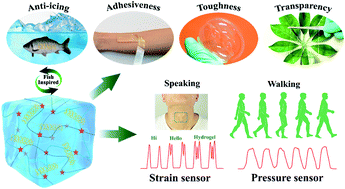Fish-inspired anti-icing hydrogel sensors with low-temperature adhesion and toughness†
Abstract
Breaking through the conventional way of conferring anti-icing ability on hydrogels with addition of organic solvents or inorganic salts, here a novel anti-icing hydrogel with toughness, adhesiveness and high transparency was successfully fabricated by introducing antifreeze protein (AFPS, inspired by fish) into a chemical crosslinking network copolymerized with acrylamide and 2-acrylamide-2-methylpropanesulfonic acid. The hydrogel exhibited surprising stretchability (up to 2400% tensile strain), high transparency (over 90% transmittance) and outstanding reversible adhesive performance bonding to different materials and even human skin. Meanwhile, the inhibition of ice crystal growth based on AFPS molecules also conferred anti-icing ability on the hydrogels, so that the toughness and adhesiveness of the hydrogels remained stable at −10 °C. Additionally, the existence of sulfonic groups also endowed the hydrogels with deformation sensitivity to act as strain or pressure sensors to accurately monitor human motions and even subtle physiological signals. Therefore, the novel anti-icing strategy would provide new insight for a new generation of hydrogel sensors.



 Please wait while we load your content...
Please wait while we load your content...